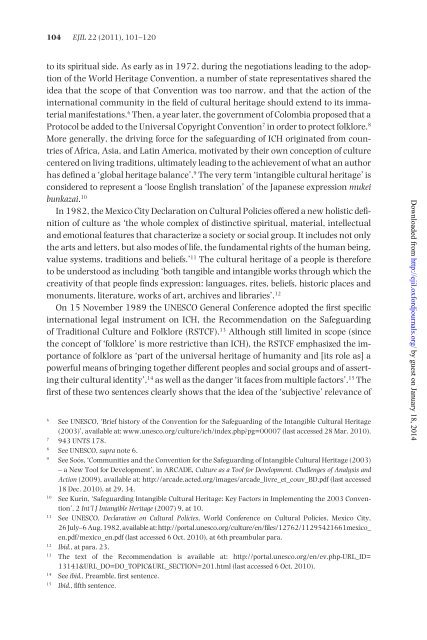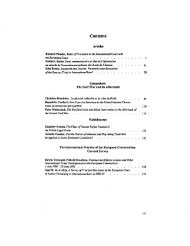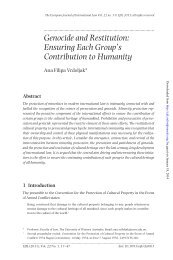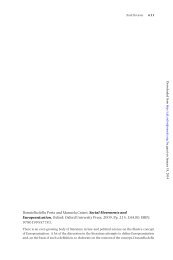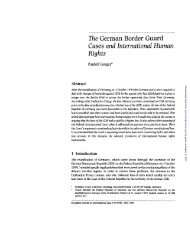Intangible Cultural Heritage - European Journal of International Law
Intangible Cultural Heritage - European Journal of International Law
Intangible Cultural Heritage - European Journal of International Law
You also want an ePaper? Increase the reach of your titles
YUMPU automatically turns print PDFs into web optimized ePapers that Google loves.
104 EJIL 22 (2011), 101–120<br />
to its spiritual side. As early as in 1972, during the negotiations leading to the adoption<br />
<strong>of</strong> the World <strong>Heritage</strong> Convention, a number <strong>of</strong> state representatives shared the<br />
idea that the scope <strong>of</strong> that Convention was too narrow, and that the action <strong>of</strong> the<br />
international community in the field <strong>of</strong> cultural heritage should extend to its immaterial<br />
manifestations. 6 Then, a year later, the government <strong>of</strong> Colombia proposed that a<br />
Protocol be added to the Universal Copyright Convention 7 in order to protect folklore. 8<br />
More generally, the driving force for the safeguarding <strong>of</strong> ICH originated from countries<br />
<strong>of</strong> Africa, Asia, and Latin America, motivated by their own conception <strong>of</strong> culture<br />
centered on living traditions, ultimately leading to the achievement <strong>of</strong> what an author<br />
has defined a ‘global heritage balance’. 9 The very term ‘intangible cultural heritage’ is<br />
considered to represent a ‘loose English translation’ <strong>of</strong> the Japanese expression mukei<br />
bunkazai. 10<br />
In 1982, the Mexico City Declaration on <strong>Cultural</strong> Policies <strong>of</strong>fered a new holistic definition<br />
<strong>of</strong> culture as ‘the whole complex <strong>of</strong> distinctive spiritual, material, intellectual<br />
and emotional features that characterize a society or social group. It includes not only<br />
the arts and letters, but also modes <strong>of</strong> life, the fundamental rights <strong>of</strong> the human being,<br />
value systems, traditions and beliefs.’ 11 The cultural heritage <strong>of</strong> a people is therefore<br />
to be understood as including ‘both tangible and intangible works through which the<br />
creativity <strong>of</strong> that people finds expression: languages, rites, beliefs, historic places and<br />
monuments, literature, works <strong>of</strong> art, archives and libraries’. 12<br />
On 15 November 1989 the UNESCO General Conference adopted the first specific<br />
international legal instrument on ICH, the Recommendation on the Safeguarding<br />
<strong>of</strong> Traditional Culture and Folklore (RSTCF). 13 Although still limited in scope (since<br />
the concept <strong>of</strong> ‘folklore’ is more restrictive than ICH), the RSTCF emphasized the importance<br />
<strong>of</strong> folklore as ‘part <strong>of</strong> the universal heritage <strong>of</strong> humanity and [its role as] a<br />
powerful means <strong>of</strong> bringing together different peoples and social groups and <strong>of</strong> asserting<br />
their cultural identity’, 14 as well as the danger ‘it faces from multiple factors’. 15 The<br />
first <strong>of</strong> these two sentences clearly shows that the idea <strong>of</strong> the ‘subjective’ relevance <strong>of</strong><br />
6<br />
See UNESCO, ‘Brief history <strong>of</strong> the Convention for the Safeguarding <strong>of</strong> the <strong>Intangible</strong> <strong>Cultural</strong> <strong>Heritage</strong><br />
(2003)’, available at: www.unesco.org/culture/ich/index.php?pg=00007 (last accessed 28 Mar. 2010).<br />
7<br />
943 UNTS 178.<br />
8<br />
See UNESCO, supra note 6.<br />
9<br />
See Soós, ‘Communities and the Convention for the Safeguarding <strong>of</strong> <strong>Intangible</strong> <strong>Cultural</strong> <strong>Heritage</strong> (2003)<br />
– a New Tool for Development’, in ARCADE, Culture as a Tool for Development. Challenges <strong>of</strong> Analysis and<br />
Action (2009), available at: http://arcade.acted.org/images/arcade_livre_et_couv_BD.pdf (last accessed<br />
18 Dec. 2010), at 29, 34.<br />
10<br />
See Kurin, ‘Safeguarding <strong>Intangible</strong> <strong>Cultural</strong> <strong>Heritage</strong>: Key Factors in Implementing the 2003 Convention’,<br />
2 Int’l J <strong>Intangible</strong> <strong>Heritage</strong> (2007) 9, at 10.<br />
11<br />
See UNESCO, Declaration on <strong>Cultural</strong> Policies, World Conference on <strong>Cultural</strong> Policies, Mexico City,<br />
26 July–6 Aug. 1982, available at: http://portal.unesco.org/culture/en/files/12762/11295421661mexico_<br />
en.pdf/mexico_en.pdf (last accessed 6 Oct. 2010), at 6th preambular para.<br />
12<br />
Ibid., at para. 23.<br />
13<br />
The text <strong>of</strong> the Recommendation is available at: http://portal.unesco.org/en/ev.php-URL_ID=<br />
13141&URL_DO=DO_TOPIC&URL_SECTION=201.html (last accessed 6 Oct. 2010).<br />
14<br />
See ibid., Preamble, first sentence.<br />
15<br />
Ibid., fifth sentence.<br />
Downloaded from http://ejil.oxfordjournals.org/ by guest on January 18, 2014


